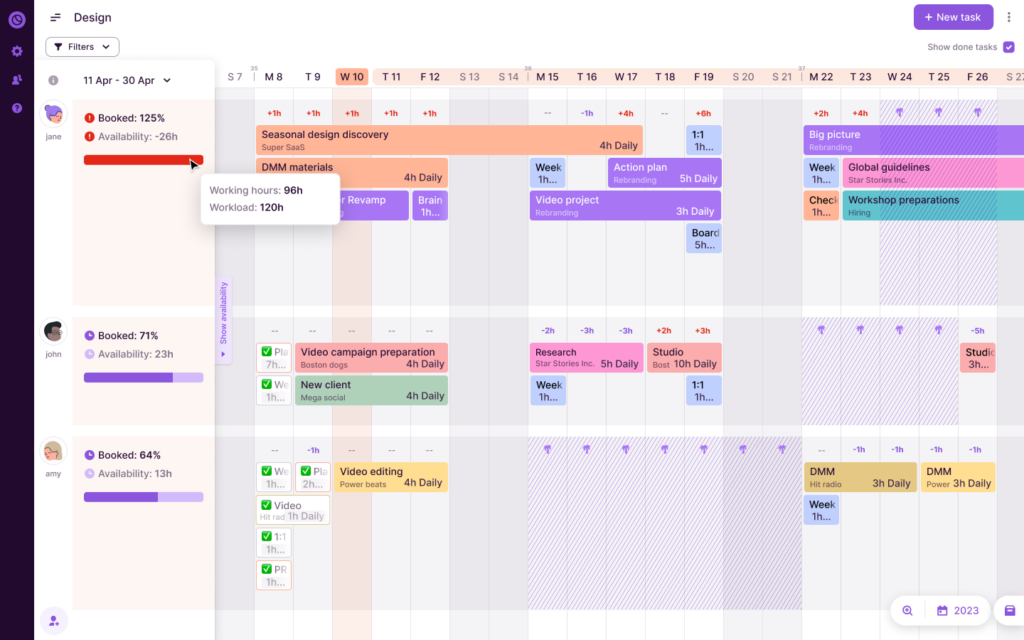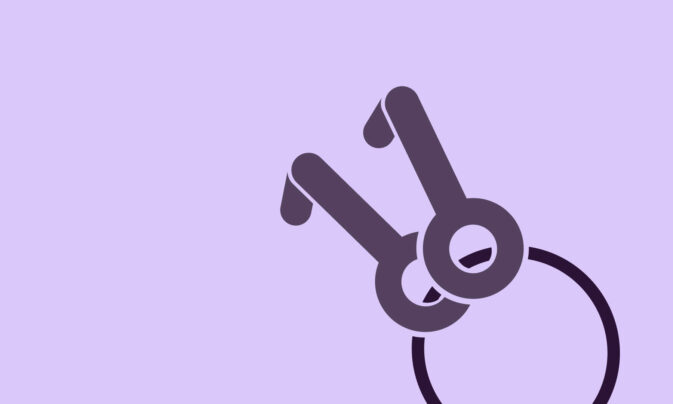In this article, you’ll learn about the three types of capacity planning strategies — lag, lead, and match. You’ll learn:
- What each strategy means
- Their advantages and disadvantages
- And a practical example for each strategy
But first:
Let’s quickly recap what capacity planning is.
Capacity planning is the process of balancing organizational capacity to meet customer demand.
The capacity planning process is vital for all businesses but crucial for service agencies. Agencies provide services that require a high level of expertise and knowledge. This limitation means they need the correct number of qualified staff available to meet demand.
Capacity planning strategies provide a framework for balancing resource capacity.
Let’s look at each of these strategies in detail.
Lag Strategy
The lag strategy is the most conservative approach to capacity planning.
It involves waiting until actual demand increases before adding capacity. This strategy can help minimize costs but lead to lost customers and revenue if demand rises quickly.

The lag strategy is a good option for organizations with a stable customer base and demand that will not fluctuate significantly. It is also a good option for organizations with a limited budget or time to add capacity.
Advantages of the Lag strategy
- Minimizes costs: The lag strategy is the most cost-effective approach to capacity planning. You save on resource costs because you only add capacity when needed. As a result, it helps avoid unnecessary expenses.
- Reduces risk: The lag strategy can reduce the risk of excess capacity. Overcapacity reduces because you only add capacity when confident that demand will increase.
Disadvantages of the Lag strategy
- Can lead to lost customers: If demand increases quickly, the lag strategy can lead to lost customers. This loss is because you may not be able to meet market demand, which can lead to customer dissatisfaction and churn.
- Can lead to revenue loss: The lag strategy can also lead to revenue loss. The revenue loss is because you cannot capture all the available demand, which can lead to lost revenue opportunities.
Example of the Lag strategy in action
A content marketing agency that provides content writing services might use the lag strategy.
The demand for content writing services typically stays the same throughout the year. As a result, the agency could wait until actual demand increases before adding extra staff, which would help cut costs.
In conclusion, this strategy suits capacity management in a content marketing agency.
Lead strategy
The lead strategy is the opposite of the lag strategy.
It involves adding resource capacity in anticipation of future demand. This strategy can help to ensure that you can meet customer demand, but it can also lead to excess capacity and wasted resources if demand does not increase as expected.

This strategy is a good option for organizations with a volatile customer base or expecting demand to increase. It is also a good option for organizations willing to take on some risk to ensure they can meet demand.
Advantages of the Lead Strategy
- Ensures meeting demand: The lead strategy can help you match the demand, even if it increases quickly. This advantage is because you have already added capacity in anticipation of the increase in demand.
- Reduces risk of lost customers: The lead strategy can help to reduce the risk of lost customers. You lose fewer customers because you are more likely to meet demand, which helps avoid customer dissatisfaction and churn.
Disadvantages of the Lead Strategy
- Can lead to overcapacity: The lead strategy can lead to excess capacity if demand does not increase as expected. This disadvantage can result in underutilized resources and increased costs.
- Can increase risk: The lead strategy can increase risk if demand does not increase as expected. Financial risks increase because you may have added capacity you do not need, which can lead to financial losses.
Example of the Lead Strategy in Action
Event management or tourism agencies might use the lead strategy.
The demand for event and tourism-related services is typically seasonal. The agency could add additional staff before the season in anticipation of the increase in demand.
Hence this strategy is suitable for capacity management in event and tourism agencies.
Match strategy
The match strategy offers a middle ground between the lag and lead strategies.
It involves adding capacity in direct proportion to demand. This strategy helps minimize costs while still ensuring that you can meet demand.

The match strategy is ideal for organizations with a moderately volatile customer base and demand. It is also a good option for organizations that want to avoid the risks of both the lag and lead strategies.
Advantages of the Match Strategy
- Minimizes costs and risks: The match strategy can reduce costs and risks. You can achieve this because you add only capacity when needed but also enough to meet demand.
- Increases flexibility: The match strategy can increase flexibility. This advantage is because you can adjust capacity as demand fluctuates, which can help you to avoid overcapacity or lost customers.
Disadvantages of the Match Strategy
- Can be difficult to implement: The Match strategy can be difficult to implement, especially if demand is highly volatile. You need experts to forecast market demand and add capacity accurately.
- Recruiting people on short notice can be difficult: While you can quickly fulfill industrial demand, hiring and onboarding people often takes much more time.
- Can be expensive: This is because you are adding capacity even when demand is not increasing. However, the match strategy can also help you to avoid the costs of lost customers and revenue.
Example of the Match Strategy in Action
An agency that provides consulting services might use the match strategy.
The demand for consulting services fluctuates depending on the economic climate. In a strong economy, the demand may increase, while demand in a weak economy may decline.
As a result, a consultancy could use the match strategy to add capacity directly in proportion to demand.
Which capacity planning strategy is right for you?
Of the three types of capacity planning strategies — lag, lead, and match — the best strategy for your agency depends on the following:
- Nature of your business
- Customer base
- Market demand
- Appetite for financial risks
The lag strategy may be a good option if you have a stable customer base and are confident that demand will not fluctuate significantly.
However, the lead or match strategy may be better if you have a slightly volatile customer base or expect demand to increase.
How to implement a capacity planning strategy?
There are four steps in the capacity planning process are as follows:
- Determine capacity. This exercise includes your team members, their skills, and availability. Plus, other resources, such as software licenses, hardware, and office space.
- Estimate demand. Estimating demand includes anticipating future workload. This process includes the number of projects, the amount of work involved, and the deadlines for each project.
- Match resources to demand. This activity involves ensuring you have enough available resources to meet your services’ demand.
- Monitor capacity and make adjustments. The step means regularly reviewing your capacity plan and making changes as your business grows or needs change.
Using capacity planning tools to implement a strategy
Resource management and capacity planning tools, like Toggl Plan, help you plan, track, and manage your team’s capacity.

Toggl Plan’s Team timelines help you visualize your entire team’s workload in one place. Using Team timelines, you can:
- Organize your team members by skills. For example, a web design agency could create Team timelines for designers, writers, developers, etc.
- See who’s doing what and when. As a result, you can prioritize project tasks and rebalance workload as demand increases.
- Plan time off. Schedule your team’s public holidays and vacation days on the timeline to avoid scheduling conflicts.
- Monitor availability. Use the Availability Overview panel to see each team member’s availability during a specific period and match them to demand.
- Identify over and underutilized team members. This helps distribute customer demand when it suddenly increases.
Alternatively, you can use resource planning templates to plan your agency’s capacity. However, most teams rarely update spreadsheets in real time. As a result, your capacity planning process can become time-consuming and error-prone.
Best practices for implementing a capacity strategy
Effective capacity planning is about evaluating and managing your agency’s current capacity to meet market demand.
Following best practices can help:
- Track capacity utilization. Tracking capacity utilization helps you to identify areas where you may need to add or reduce current capacity.
- Talk to your team. Understand your teams’ existing workload and time off plans. Communicate anticipated demand surges.
- Engage with your existing customers. This engagement helps anticipate demand in case customers have other projects to outsource.
- Work with other departments. For example, you could forecast new demand by talking to your sales team. Similarly, the accounting department could help you understand your financial risk capacity.
- Use capacity planning tools. Capacity planning tools help you calculate resource capacity accurately and balance workloads efficiently.
Effectively plan capacity for your business
Effective capacity planning is critical for all knowledge-based service agencies.
If agencies don’t have enough staff to meet demand, they lose customers and revenue. On the other hand, margins will suffer if the market demand is not enough to engage the staff.
There are three types of capacity planning strategies — lag, lead, and match.
Using these strategies, you can develop an effective capacity plan, improve efficiency, and achieve business goals.
Jitesh is an SEO and content specialist. He manages content projects at Toggl and loves sharing actionable tips to deliver projects profitably.




